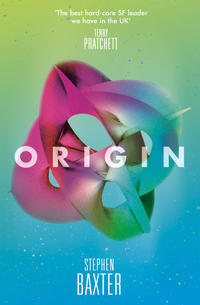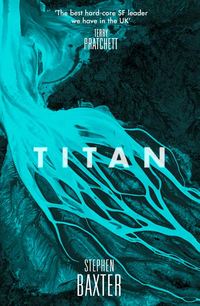
Полная версия
Time
But all too soon the ship’s languid roll brought her into the light, and brief night gave way to false day.
Rippling her fins, she swam away from the machinery cluster, away from the heart of the ship, where she lived with her shoals of fish. As she rose the water flowing through her mantle cooled, the rich oxygen thinning. She was swimming out through layers of life, and she sensed the subtle sounds of living things washing through the sphere: the smooth rush of the fish as they swam in their tight schools, the bubbling murmur of the krill on which they browsed, and the hiss of the diatoms and algae which fed them, and the deep infrasonic rumble of the water itself, compression waves pulsing through its bulk.
And just as each successive sphere of water was larger than the one it contained, so Sheena knew there was a hierarchy of life. To sustain her, there had to be ten times her weight in krill, and a hundred times in diatoms.
And if there had been other squid, of course, those numbers would increase. But there was no other squid here but herself.
For now.
She could see, through misty, life-laden water, the ship’s hull, a membrane above her like an ocean surface. Except that it wasn’t above her, as it would be in a true ocean. And there was no sandy ocean floor below. Instead the membrane was all around her, closed on itself, shimmering in great slow waves that curled around the sphere’s belly.
This was self-evidently a complex world, a curved world, a world without the simple top and bottom of the ocean; and the light was correspondingly complex, its polarization planes random, or else spiralling down around her.
But Sheena hunted in three dimensions. She could come to terms with all this strangeness. She knew she must, in fact.
She reached the wall of the ship.
The membrane was a firm, if flexible, wall. If she pushed at it, it pushed back. Human eyes could see that the wall was tinted gold. Dan had told her how beautiful this great golden egg had been in the skies of Earth, as it receded to the stars. Sheena ship good pretty, he said. Like Earth. Ship people see, gold bubble, ship of water …
Grass algae grew on the wall, their long filaments dangling and wafting in the currents. Crabs and shellfish grazed on the grass algae. The benthic grazers helped feed her, and in the process kept the walls clean.
Every creature in this small ocean had a part to play. Here, for instance, she drifted past a floating bank of seaweed. The seaweed cleaned the water, and used up drifting food that the algae and diatoms could not consume. And the seaweed was useful in itself. One of Sheena’s jobs was to gather the weed, when it grew too thick, and deliver it to a hopper in the machinery cluster. There it could be spun into fibres that Dan called sea silk. The sea silk would be used when she got to her destination, to make and repair the equipment she would use there.
Now the ship’s slow rotation carried Sheena into the light of a milky, blurred disc. It was the sun – dimmed by the membrane so it did not hurt her eyes – with, near it, a smaller crescent. That, she knew, was the Earth, all its great oceans reduced to a droplet. The craft scooted around the sun after Earth like a fish swimming after its school, seeking the rock that was the target for this mission.
Once, swimming under the arching membrane like this, she had been startled by a starburst of light, only a few moments’ swim from her. It had disappeared as soon as it had occurred – but it seemed to her that there was a flaw in the membrane, a small patch that had lost its lustrous glow; and she could see from the muddled polarization how the composition of the water had been disturbed beneath the flaw.
Then she had seen something moving, outside the membrane. She cowered, flashed signals of false threat and concealment, thinking it was some deep space predator.
It was no predator. It was just a box that squirted back and forth, emitting gentle little farts of glittering crystals. It was pulling a patch over the hole.
Dan told her it was a firefly robot, a smart little box with its own power supply and fuel and miniaturized machinery and cameras and machine intelligence. The ship carried a shoal of these small craft for external inspection and repairs like this.
But the little craft’s life was limited, intended for a single use only, and it could achieve only one thing, which was to fix the membrane – unlike Sheena, who could do many different things. When its job was done, its fuel expended, the craft neatly folded away its tool-bearing arms, and used the last breath of its fuel to push itself away from the ship. Sheena had watched as the little craft, discarded, dwindled to a sunlit point.
She had learned that her ship leaked all the time anyway, from tiny flaws and miniature punctures. And every few days the throwaway robots would scuttle over the membrane, tracking the vapour clouds, fixing the worst of the leaks, before sacrificing themselves.
She let the lazy, whale-like roll of the ship carry her away from the glare of the sun, and she peered into the darkness, where she could see the stars.
The stars were important. She had been trained to recognize many of them. When she had memorized their positions around the ship she would return to the machinery cluster and work the simple controls Dan had given her. By this means she could determine her position in space far more accurately than even Dan could have, from far-off Earth.
Then the rockets would flare, sending hails of exhaust particles shooting into space. They would push at the hide of the ship like a squid shoving at the belly of a whale. Waves, flaring with light, pulsed back and forth across the meniscus, illuminating the drifting clouds of algae, and Sheena could detect the subtle wash of gravity around her as the great mass of water was nudged back to its proper trajectory.
But to Sheena the stars were more than navigation beacons. Sheena’s eyes had a hundred times the number of receptors of human eyes, and she could see a hundred times as many stars.
To Sheena the universe was crowded with stars, vibrant and alive. The Galaxy was a reef of stars beckoning her to come jet along its length.
But there was only Sheena here to see it.
She found it hard to rest.
Sheena was utterly alone. Though she knew there were no predators here, that she was as safe as any squid had ever been, she could not rest: not without the complex protection of the shoal around her, its warnings and sentinels. And, of course, without the shoal she was cut off from the society of the squid, the mating and learning and endless dances of daylight.
Dan had provided a kind of dream shoal for her: squid-like shapes that swam and jetted around her, glimmering. But the polarization of the light from their false hides was subtly wrong, and the fake shoal was no comfort. She was surprised Dan had not understood.
As the mission progressed, as she grew progressively more weary, her loyalty to Dan crumbled, grain by grain.
e-CNN:
… And we return to our main story, the developing crisis around the illegal space launch by the Bootstrap corporation from their Mojave facility. It has become clear that the authorities, far from granting the approvals Bootstrap is seeking, were in fact moving to close down the operation completely. Joe …
… Thanks, Madeleine. We do know that Cruithne was not the original target of Reid Malenfant’s interplanetary ambitions. Originally he was planning to head for Reinmuth, another asteroid that is much richer in metals than Cruithne. So, why Cruithne?
It’s now emerged, from sources inside Bootstrap itself, that in recent months Malenfant has become convinced that the world itself may be coming to an end. And this global doom is somehow linked to asteroid Cruithne. What are we to make of this remarkable twist in this spectacular story?
We’ve been trying to determine if there is more to Malenfant’s fears about the future than mere paranoia. It is said there are respectable scientists who claim that it is a statistical fact that the world will end, taking all of us with it, in just a few centuries. Apparently this has been known in government circles since the 1980s. Again the Administration declined to comment. Madeleine …
Joe, Reid Malenfant, fifty-one, is highly charismatic and popular. Since the announcement of his interplanetary venture he has become something of a cult figure. In fact last year’s best-selling Christmas toys were models of Bootstrap’s so-called Big Dumb Booster, along with action figures and animated holograms of the intelligent squid crew, and even of Reid Malenfant himself.
But, while undoubtedly an attractive figure, Malenfant has long been regarded by commentators as an unstable personality.
However Bootstrap spokespersons are saying this is all scurrilous rumour put out by enemies of Reid Malenfant, perhaps within his own corporation …
John Tinker:
Yes, they threw me out of the Flying Mountain Society. Screw them.
And screw Reid Malenfant. Malenfant is a wimp.
Yes, he got his bird off the ground. But to continue to launch with 1940s-style chemical rockets is at best a diversion, at worst a catastrophic error.
People, you can’t lift diddley into space by burning chemicals.
There has been a solution on the drawing boards since the 1960s. Project Orion.
You take a big plate, attach it by shock-absorbers to a large capsule, and throw an atomic bomb underneath.
Your ship will move, believe me.
Then you throw another bomb, and another.
For an expenditure of a small part of the world’s nuclear stockpile you could place several million pounds in orbit.
I believe in the dream. I believe we should aim to lift a billion people into space by the end of the century. This is the only way to establish a population significant enough to build a genuine spacegoing industry infrastructure – and, incidentally, the only way to lift off enough people to make a dent in the planet’s population problem.
Yes, this will cause some fallout. But not much, compared to what we already added to the background radiation. What’s the big deal?
Malenfant is right; we are facing a crisis over the survival of the species. Hard times make for hard choices. Omelettes and eggs, people.
Anyhow, those bombs aren’t going to go away. If America doesn’t use them, somebody else will …
Art Morris:
My name is Art Morris and I am forty years old. I am a Marine, or used to be until I got disabled out.
My most prized possession is a snapshot of my daughter, Leanne.
In the snap she’s at her last birthday party, just five years old, in a splash of Florida sunshine. The snap’s one of those fancy modern ones that can show you movement, and it cycles through a few seconds of Leanne blowing at her cake. And it has a soundtrack. If you listen under the clapping and whoops of the family and the other kids, you can just hear her wheeze as she took her big breath. What you can’t see off the edge of the picture is me, just behind Leanne’s shoulder, taking a blow myself to make sure those damn candles did what she wanted them to do, making sure that something in her world worked, just once.
It wasn’t long after that that we had to put her into the ground. I didn’t understand half of what the doctors told me was wrong with her, but I got the headline.
She was a yellow baby, a space baby, a rocket baby.
Maybe by now she would have been one of these smart kids the news is full of. But she never got the chance.
I rejoiced when they shut down the space program. But now those assholes in the desert have started firing off their damn rockets again, regardless.
I keep Leanne’s picture taped to the dash of my car, or in my pocket.
Look what you did, Reid Malenfant.
Reid Malenfant:
Madame Chairman, this is not some wacko stunt. It is a sound business venture.
Here’s the plan from here on in.
Cruithne is a ball of loosely aggregated dirt: probably eighty per cent silicates, sixteen per cent water, two per cent carbon, two per cent metals. This is an extraordinarily rich resource.
Our strategy is to aim for the simplest technologies, fast return, fast payback.
The first thing we’re going to make up on Cruithne is rocket fuel. The fuel will be a methane-oxygen bipropellant.
Then we’ll start bagging up permafrost water from the asteroid, along with a little unprocessed asteroid material. We’ll use the propellant to start firing water back to Earth orbit – specifically, a type of orbit called HEEO, a highly eccentric Earth orbit, which in terms of accessibility is a good compromise place to store extraterrestrial materials.
Thus we will build a pipeline from Cruithne to Earth orbit.
This will not be a complex operation. The methane rockets are based on tried and trusted Pratt and Whitney designs. The cargo carriers will be little more than plastic bags wrapped around big dirty ice cubes.
But in HEEO this water will become unimaginably precious. We can use it for life support and to make rocket fuel. We think Nautilus should be able to return enough water to fuel a further twenty to fifty NEO exploration missions, at minimal incremental cost. This is one measure of the payback we’re intending to achieve. Also we can sell surplus fuel to NASA.
But we are also intending to trial more complex extraction technologies on this first flight. With suitable engineering, we can extract not just water but also carbon dioxide, nitrogen, sulphur, ammonia, phosphates – all the requirements of a life support system. We will also be able to use the asteroid dirt to make glass, fibreglass, ceramics, concrete, dirt to grow things in.
We are already preparing a crewed follow-up mission to Cruithne which will leverage this technology to establish a colony, the first colony off the planet. This will be self-sufficient, almost from day one.
And the colonists will pay their way by further processing the Cruithne dirt to extract its metals. The result will be around ninety per cent iron, seven per cent nickel, one per cent cobalt, and traces. The trace, however, includes platinum, which may be the first resource returned to the surface of the Earth; nickel and cobalt will probably follow.
(Incidentally I’m often asked why I’m going to the asteroids first, rather than the Moon. The Moon seems easier to get to, and is much bigger than any asteroid besides. Well, the slag that is left over after we extract the water and volatiles and metals from asteroid ore – the stuff we’d throw away – that slag is about equivalent to the richest Moon rocks. That’s why I ain’t going to the Moon.)
Later we’ll start the construction of a solar power plant in Earth orbit. The high-technology components of the plant, such as guidance, control, communications, power conversion and microwave transmission systems, will be assembled on Earth. The massive low-tech components – wires, cables, girders, bolts, fixtures, station-keeping propellants and solar cells – will all be manufactured in space from asteroid materials. This plan reduces the mass that will have to be lifted into Earth orbit several-fold. This plant will produce energy – safe, clean, pollution-free – we can sell back to Earth.
Конец ознакомительного фрагмента.
Текст предоставлен ООО «ЛитРес».
Прочитайте эту книгу целиком, купив полную легальную версию на ЛитРес.
Безопасно оплатить книгу можно банковской картой Visa, MasterCard, Maestro, со счета мобильного телефона, с платежного терминала, в салоне МТС или Связной, через PayPal, WebMoney, Яндекс.Деньги, QIWI Кошелек, бонусными картами или другим удобным Вам способом.











